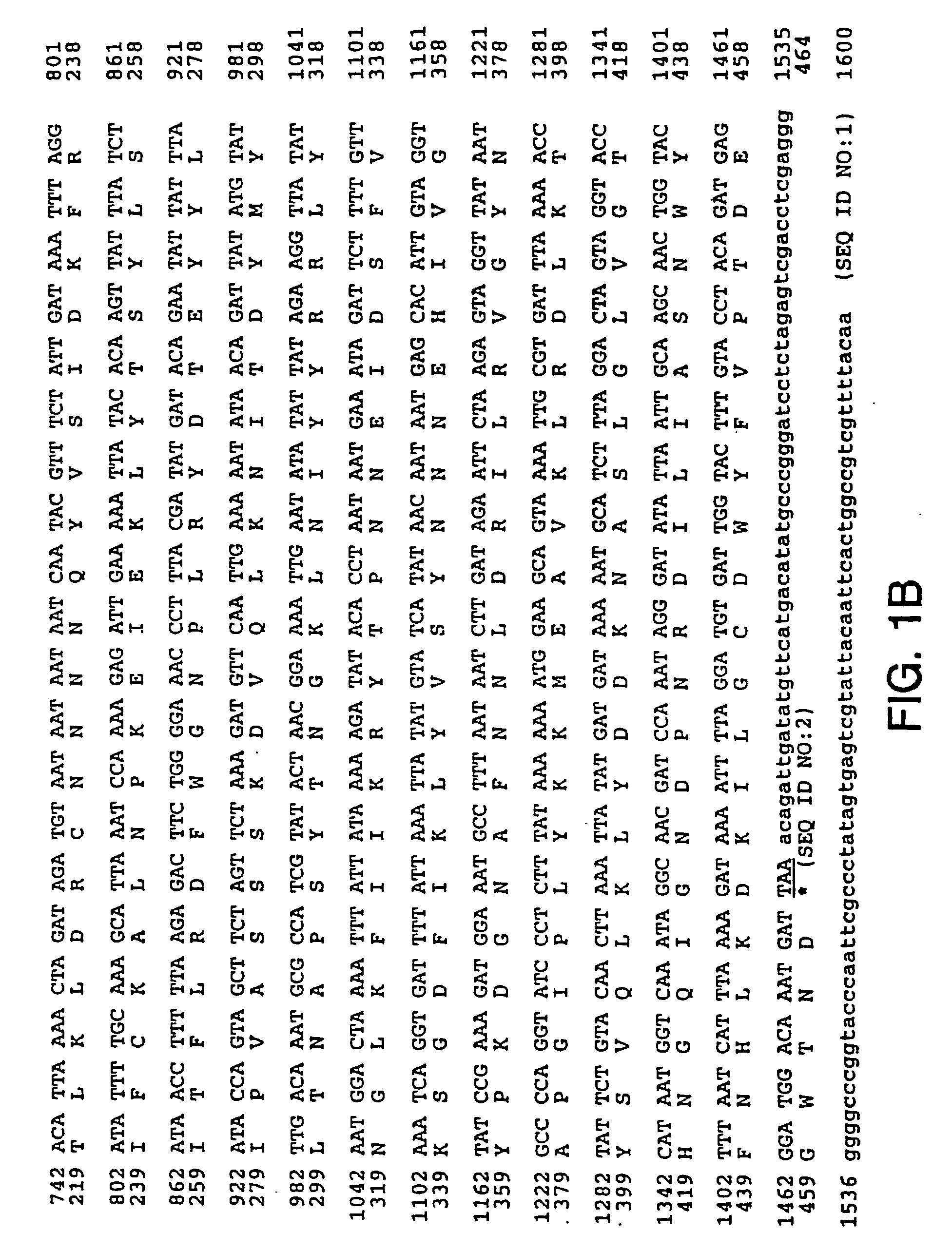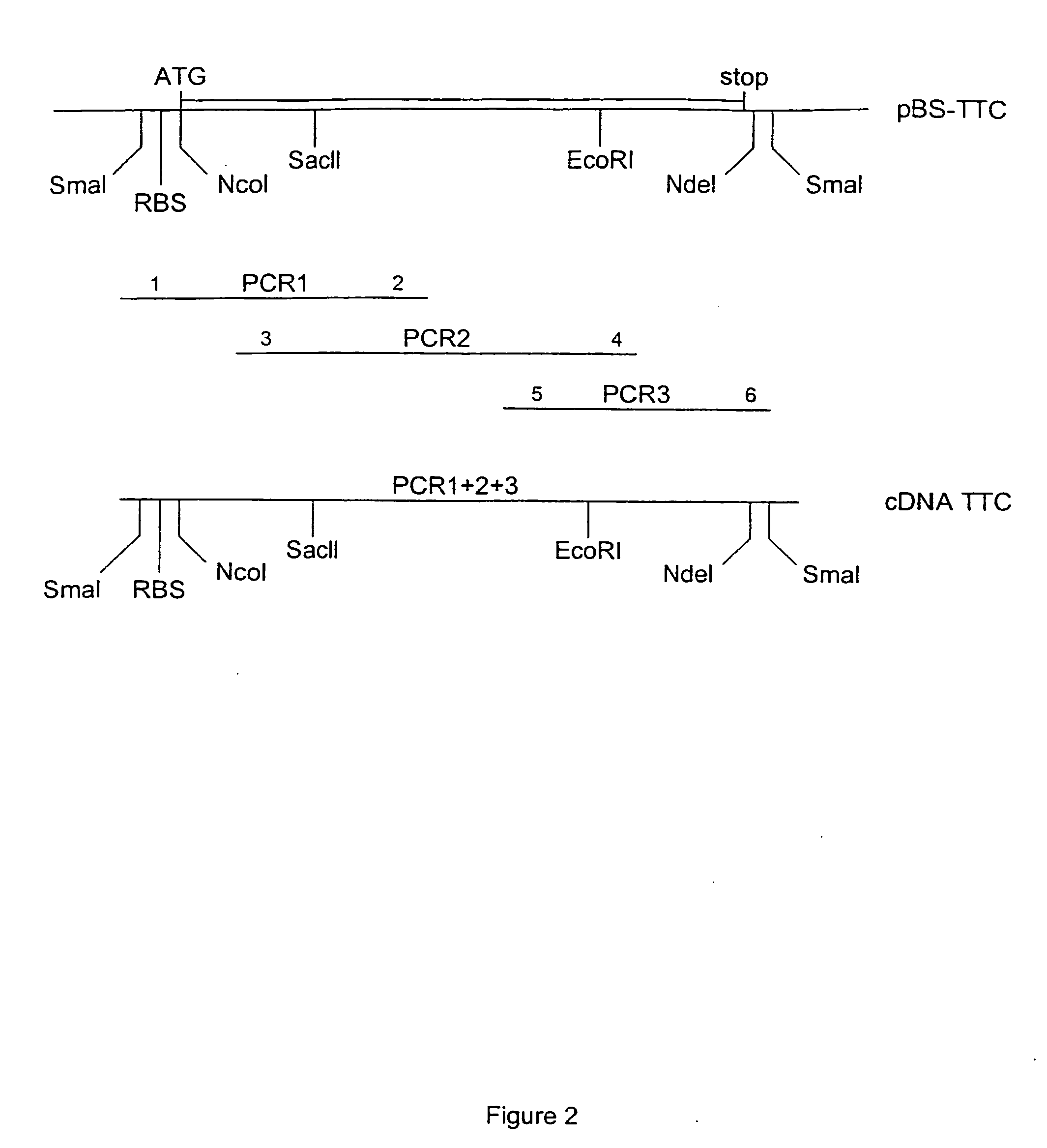Methods for direct visualization of active synapses
a synapse and active technology, applied in the field of can solve the problems of difficult caveats and elusive direct visualization of active synapses in complex neuronal networks, and achieve the effects of improving the transport of fragments, modulating neuronal transport, and easy manipulation of composition
- Summary
- Abstract
- Description
- Claims
- Application Information
AI Technical Summary
Benefits of technology
Problems solved by technology
Method used
Image
Examples
example 1
Plasmid Constructions
[0130] (A) TTC Cloning:
[0131] Full length TTC DNA was generated from the genomic DNA from the Clostridium Tetani strain (a gift from Dr. M. Popoff, Institut Pasteur) using PCR. Three overlapping fragments were synthesized: PCR1 of 465 bp (primer 1: 5′-CCC CCC GGG CCA CCA TGG TTT TTT CAA CAC CAA TTC CAT TTT CTT ATT C-3′ and primer 2: 5′-CTA AAC CAG TAA TTT CTG-3′), PCR2 of 648 bp (primer 3: 5′-AAT TAT GGA CTT TAA AAG ATT CCG C-3′ and primer 4: 5′-GGC ATT ATA ACC TAC TCT TAG AAT-3′) and PCR3 of 338 bp (primer 5: 5′-AAT GCC TTT AAT AAT CTT GAT AGA AAT-3′ and prirner 6: 5′-CCC CCC GGG CAT ATG TCA TGA ACA TAT CAA TCT GTT TAA TC-3′). The three fragments were sequentially introduced into pBluescript KS+ (Stratagene) to give pBS:TTC plasmid. The upstream primer 1 also contains an optimized eukaryotic Ribosome Binding Site (RBS) and translational initiation signals. Our TTC fragment (462 amino acids) represents the amino acids 854-1315 of tetanus holotoxin, i.e. the ca...
example 2
Purification of the Hybrid Protein
[0139] The E. coli strain SR3315 (a gift from Dr. A. Pugsley, Institut Pasteur) transfected with pGEX:lacz-TTC was used for protein production. An overnight bacterial culture was diluted 1:100 in LB medium containing 100 μg / ml ampicillin, and grown for several hours at 32° C. until an OD of 0.5 was reached. Induction from the Ptac promoter was achieved by the addition of I mM IPTG and 1 mM MgCl2 and a further 2 hrs incubation. The induced bacteria were pelleted by centrifugation for 20 min at 3000 rpm, washed with PBS and resuspended in lysis buffer containing 0.1M Tris pH 7.8, 0.1M NaCl, 20% glycerol, 10 mM EDTA, 0.1% Triton-X100, 4 mM DTT, 1 mg / ml lysosyme, and a mixture of anti-proteases (100 μg / ml Pefablok, 1 μg / ml leupeptin, 1 μg / ml pepstatin, 1 mM benzamidine). After cell disruption in a French Press, total bacterial lysate was centrifuged for 10 min at 30000 rpm. The resulting supernatant was incubated overnight at 4° C. with the affinity ma...
example 3
Binding and Internalization of Recombinant Protein in Differentiated 1009 Cells
[0141] The 1009 cell line was derived from a spontaneous testicular teratocarcinoma arising in a recombi nant inbred mouse strain (129×B6) (17). The 1009 cells were grown in Dulbecco's modified Eagle's medium (DMEM) containing 10% fetal calf serum and passaged at subconfluence. In vitro differentiation with retinoic acid and cAMP was performed as described (18). Eight days after retinoic acid treatment, cells were used for the internalization experiments with either the hybrid protein or β-gal.
[0142] Binding and internalization of the β-Gal-TTC fusion were assessed using a modified protocol (16). Differentiated 1009 cells were incubated for 2 hrs at 37° C. with 5 μg / ml of β-Gal-TTC or β-Gal protein diluted in binding buffer (0.25% sucrose, 20 mM Tris acetate 1 mM CaCl2, 1 mM MgCl2, 0.25% bovine serum albumin, in PBS). The cells were then incubated with 1 μg / ml Pronase E (Sigma) in PBS for 10 min at 37° ...
PUM
| Property | Measurement | Unit |
|---|---|---|
| diameter | aaaaa | aaaaa |
| size | aaaaa | aaaaa |
| OD | aaaaa | aaaaa |
Abstract
Description
Claims
Application Information
 Login to View More
Login to View More - R&D
- Intellectual Property
- Life Sciences
- Materials
- Tech Scout
- Unparalleled Data Quality
- Higher Quality Content
- 60% Fewer Hallucinations
Browse by: Latest US Patents, China's latest patents, Technical Efficacy Thesaurus, Application Domain, Technology Topic, Popular Technical Reports.
© 2025 PatSnap. All rights reserved.Legal|Privacy policy|Modern Slavery Act Transparency Statement|Sitemap|About US| Contact US: help@patsnap.com



